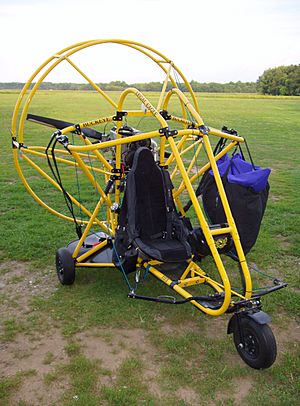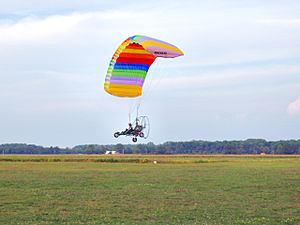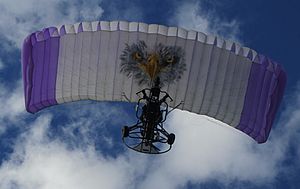Powered parachute facts for kids
A powered parachute (often called a PPC or paraplane) is a special type of aircraft. It has a big fabric wing, like a parachute, and a motor with wheels. Think of it as a small, open-air vehicle that flies!
PPCs usually fly quite slowly, around 25–35 miles per hour (40–60 km/h). They can fly very low, just a few feet off the ground, which is fun for "fly-bys." They can also go much higher, up to 10,000 feet (3 km), but most flights are between 500 and 1500 feet (150–500 meters) high.
These aircraft can fly for about three hours on a full tank of fuel. They also need very little space to take off and land, sometimes less than 100 feet (30 meters)!
PPCs are one of the cheapest ways to fly. A new single-seat powered parachute might cost around $10,000, while a two-seat one starts at about $20,000. They are also quite light, weighing between 200–500 pounds (90–225 kg).
In the United States, some small single-seat PPCs are called "ultralight aircraft." This means you might not need a special license to fly them, but getting lessons is always a good idea! Most people can learn to fly a PPC safely with 5 to 10 hours of lessons. Bigger two-seat PPCs are called "light sport aircraft." For these, you need a special pilot certificate from the FAA. This usually takes at least 12 hours of flight lessons.
Contents
Understanding Powered Parachutes and Paragliders
Many people get powered parachutes (PPCs) and powered paragliders (PPGs) mixed up. They can look similar from the ground.
The easiest way to tell them apart is by how they are steered:
- PPCs use your feet to push on steering bars.
- PPGs use your hands to control the steering lines.
PPCs always have a wheeled frame (like a cart or trike) that you sit in. Powered paragliders usually involve launching by foot, though some do have wheeled frames as an extra option. Also, the fabric wing of a paraglider often looks thinner and more oval-shaped.
How Safe Are Powered Parachutes?
Powered parachutes are often thought to be safer than regular airplanes. This is because they are very stable and don't easily lose control or stall (which is when the wing stops producing enough lift).
You control a PPC in two main ways:
- You change the engine power to go up or down.
- You use your feet to move steering bars, which turn the aircraft left or right.
If you pull both steering bars at the same time, the aircraft "flares." This means it slows down and gets a little extra lift, which is very useful for smooth landings.
If the engine stops, a PPC can still glide down safely. It can glide about 3 to 6 feet forward for every 1 foot it drops. As long as you are close enough to a good landing spot and know how to "flare" properly, you can land safely even without engine power. Flaring helps to slow the aircraft down just before touching the ground, making the landing much softer.
It's very hard to make a powered parachute get into a dangerous position or for its wing to collapse just by how you fly it. The wing is designed to be very stable. If a wing does collapse (which is rare), it usually re-inflates right away, and the pilot might not even notice. Most accidents happen because of pilot error, not because of the aircraft itself.
The main dangers when flying a PPC are strong winds and obstacles. It's best not to fly if the wind is stronger than 10–15 miles per hour or if it's gusty. You also need to watch out for things like power lines, trees, and other tall objects, especially when flying low.
What Are Powered Parachutes Used For?
PPC pilots often love flying low and slow. This makes powered parachutes great for:
- Sightseeing: You get amazing views of the landscape below.
- Photography: It's easy to take pictures from a PPC.
PPCs are also sometimes used in other ways:
- Farming: They can be used to check on crops or livestock.
- Law Enforcement: Some police departments use them for observing areas, helping to find suspects, or taking photos of crime scenes. They are much cheaper than helicopters.
- Emergency Services: In some places, like the Amazon rainforest in Ecuador, special PPCs are designed to help provide medical services to remote communities.
- Scouting for Hunting: While it's usually against the law to hunt from an aircraft, PPCs can be used to find animals or herds before a hunting season begins. Their slow speed makes them good for this.
PPCs don't need a big airport to take off and land. Many pilots fly from small fields or even their own backyards!
In the United States, ultralight PPCs are not allowed to fly at night or over crowded cities. However, if you have the right pilot certificate and a properly equipped PPC, you can fly at night or over metropolitan areas.
Model Engineering
You can even find radio-controlled models of powered parachutes! These small versions are fun to fly too.





